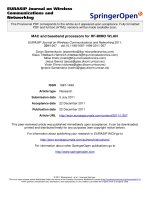Wireless communications and networking
Bạn đang xem bản rút gọn của tài liệu. Xem và tải ngay bản đầy đủ của tài liệu tại đây (15.41 MB, 931 trang )
WIRELESS
COMMUNICATIONS
AND NETWORKING
The Morgan Kaufmann Series in Networking
Series Editor, David Clark, M.I.T.
Wireless Communications and Networking
Vijay K. Garg
Ethernet Networking for the Small Office and
Professional Home Office
Jan L. Harrington
Network Analysis, Architecture, and Design, 3e
James D. McCabe
IPv6 Advanced Protocols Implementation
Qing Li, Tatuya Jinmei, and Keiichi Shima
Computer Networks: A Systems Approach, 4e
Larry L. Peterson and Bruce S. Davie
Network Routing: Algorithms, Protocols, and
Architectures
Deepankar Medhi and Karthikeyan Ramaswami
Deploying IP and MPLS QoS for Multiservice
Networks: Theory and Practice
John Evans and Clarence Filsfils
Traffic Engineering and QoS Optimization of
Integrated Voice & Data Networks
Gerald R. Ash
IPv6 Core Protocols Implementation
Qing Li, Tatuya Jinmei, and Keiichi Shima
Smart Phone and Next-Generation Mobile Computing
Pei Zheng and Lionel Ni
GMPLS: Architecture and Applications
Adrian Farrel and Igor Bryskin
Network Security: A Practical Approach
Jan L. Harrington
Content Networking: Architecture, Protocols, and
Practice
Markus Hofmann and Leland R. Beaumont
Network Algorithmics: An Interdisciplinary Approach
to Designing Fast Networked Devices
George Varghese
Network Recovery: Protection and Restoration of
Optical, SONET-SDH, IP, and MPLS
Jean Philippe Vasseur, Mario Pickavet, and Piet
Demeester
Routing, Flow, and Capacity Design in Communication and Computer Networks
Michał Pióro and Deepankar Medhi
Wireless Sensor Networks: An Information Processing Approach
Feng Zhao and Leonidas Guibas
Communication Networking: An Analytical Approach
Anurag Kumar, D. Manjunath, and Joy Kuri
The Internet and Its Protocols: A Comparative
Approach
Adrian Farrel
Modern Cable Television Technology: Video, Voice,
and Data Communications, 2e
Walter Ciciora, James Farmer, David Large, and
Michael Adams
Bluetooth Application Programming with the Java APIs
C Bala Kumar, Paul J. Kline, and Timothy J. Thompson
Policy-Based Network Management: Solutions for
the Next Generation
John Strassner
MPLS Network Management: MIBs, Tools, and
Techniques
Thomas D. Nadeau
Developing IP-Based Services: Solutions for Service
Providers and Vendors
Monique Morrow and Kateel Vijayananda
Telecommunications Law in the Internet Age
Sharon K. Black
Optical Networks: A Practical Perspective, 2e
Rajiv Ramaswami and Kumar N. Sivarajan
Internet QoS: Architectures and Mechanisms
Zheng Wang
TCP/IP Sockets in Java: Practical Guide for Programmers
Michael J. Donahoo and Kenneth L. Calvert
TCP/IP Sockets in C: Practical Guide for Programmers
Kenneth L. Calvert and Michael J. Donahoo
Multicast Communication: Protocols, Programming, and Applications
Ralph Wittmann and Martina Zitterbart
MPLS: Technology and Applications
Bruce Davie and Yakov Rekhter
High-Performance Communication Networks, 2e
Jean Walrand and Pravin Varaiya
Internetworking Multimedia
Jon Crowcroft, Mark Handley, and Ian Wakeman
Understanding Networked Applications: A First
Course
David G. Messerschmitt
Integrated Management of Networked Systems:
Concepts, Architectures, and their Operational
Application
Heinz-Gerd Hegering, Sebastian Abeck, and Bernhard
Neumair
Virtual Private Networks: Making the Right Connection
Dennis Fowler
Networked Applications: A Guide to the New
Computing Infrastructure
David G. Messerschmitt
Wide Area Network Design: Concepts and Tools
for Optimization
Robert S. Cahn
For further information on these books and for a
list of forthcoming titles, please visit our Web site at
.
WIRELESS
COMMUNICATIONS
AND NETWORKING
Vijay K. Garg
Amsterdam • Boston • Heidelberg
London • New York Oxford
Paris • San Diego • San Francisco
Singapore • Sydney • Tokyo
Morgan Kaufmann is an imprint of Elsevier
Senior Acquisitions Editor
Publishing Services Manager
Senior Project Manager
Associate Editor
Editorial Assistant
Cover Design
Composition
Illustration
Copyeditor
Proofreader
Indexer
Interior printer
Cover printer
Rick Adams
George Morrison
Brandy Lilly
Rachel Roumeliotis
Brian Randall
Alisa Andreola
diacriTech
diacriTech
Janet Cocker
Janet Cocker
Distributech Scientific Indexing
Sheridan Books
Phoenix Color
Morgan Kaufmann Publishers is an imprint of Elsevier.
500 Sansome Street, Suite 400, San Francisco, CA 94111
This book is printed on acid-free paper.
© 2007 by Elsevier Inc. All rights reserved.
Designations used by companies to distinguish their products are often claimed as trademarks or registered
trademarks. In all instances in which Morgan Kaufmann Publishers is aware of a claim, the product names
appear in initial capital or all capital letters. Readers, however, should contact the appropriate companies for
more complete information regarding trademarks and registration.
No part of this publication may be reproduced, stored in a retrieval system, or transmitted in any form or by any
means—electronic, mechanical, photocopying, scanning, or otherwise—without prior written permission of the
publisher.
Permissions may be sought directly from Elsevier’s Science & Technology Rights Department in Oxford,
UK: phone: (ϩ44) 1865 843830, fax: (ϩ44) 1865 853333, E-mail: You may
also complete your request on-line via the Elsevier homepage (), by selecting “Support &
Contact” then “Copyright and Permission” and then “Obtaining Permissions.”
Library of Congress Cataloging-in-Publication Data
Garg, Vijay Kumar, 1938Wireless communications and networking / Vijay K. Garg.–1st ed.
p. cm.
Includes bibliographical references and index.
ISBN-13: 978-0-12-373580-5 (casebound : alk. paper)
ISBN-10: 0-12-373580-7 (casebound : alk. paper) 1. Wireless communication systems. 2. Wireless LANs.
I. Title.
TK5103.2.G374 2007
621.382’1–dc22
2006100601
ISBN: 978-0-12-373580-5
For information on all Morgan Kaufmann publications,
visit our Web site at www.mkp.com or www.books.elsevier.com
Printed in the United States of America
07 08 09 10 11
5 4 3 2 1
Working together to grow
libraries in developing countries
www.elsevier.com | www.bookaid.org | www.sabre.org
The book is dedicated to my grandchildren — Adam, Devin, Dilan, Nevin,
Monica, Renu, and Mollie.
This page intentionally left blank
Contents
About the Author
Preface
1 An Overview of Wireless Systems
xxiii
xxv
1
1.1
Introduction
1
1.2
First- and Second-Generation Cellular Systems
2
1.3
Cellular Communications from 1G to 3G
5
1.4
Road Map for Higher Data Rate Capability in 3G
8
1.5
Wireless 4G Systems
14
1.6
Future Wireless Networks
15
1.7
Standardization Activities for Cellular Systems
17
1.8
Summary
19
Problems
20
References
20
2 Teletraffic Engineering
23
2.1
Introduction
23
2.2
Service Level
23
2.3
Traffic Usage
24
2.4
Traffic Measurement Units
25
2.5
Call Capacity
30
2.6
Definitions of Terms
32
2.7
Data Collection
36
2.8
Office Engineering Considerations
36
2.9
Traffic Types
38
2.10 Blocking Formulas
39
2.10.1 Erlang B Formula
40
2.10.2 Poisson’s Formula
41
2.10.3 Erlang C Formula
41
2.10.4 Comparison of Erlang B and Poisson’s Formulas
42
2.10.5 Binomial Formula
42
vii
viii
Contents
2.11 Summary
43
Problems
44
References
45
3 Radio Propagation and Propagation Path-Loss Models
47
3.1
Introduction
3.2
Free-Space Attenuation
48
3.3
Attenuation over Reflecting Surface
50
3.4
Effect of Earth’s Curvature
53
3.5
Radio Wave Propagation
54
Characteristics of Wireless Channel
58
3.6
3.6.1
3.7
Multipath Delay Spread, Coherence Bandwidth,
and Coherence Time
47
60
Signal Fading Statistics
62
3.7.1
Rician Distribution
63
3.7.2
Rayleigh Distribution
64
3.7.3
Lognormal Distribution
64
3.8
Level Crossing Rate and Average Fade Duration
65
3.9
Propagation Path-Loss Models
66
3.9.1
Okumura/Hata Model
67
3.9.2
Cost 231 Model
68
3.9.3
IMT-2000 Models
72
3.10 Indoor Path-Loss Models
75
3.11 Fade Margin
76
3.12 Link Margin
79
3.13 Summary
81
Problems
82
References
83
4 An Overview of Digital Communication and Transmission
85
4.1
Introduction
85
4.2
Baseband Systems
87
4.3
Messages, Characters, and Symbols
87
4.4
Sampling Process
88
4.4.1
Aliasing
91
4.4.2
Quantization
93
Contents
ix
4.4.3
Sources of Error
94
4.4.4
Uniform Quantization
95
4.5
Voice Communication
97
4.6
Pulse Amplitude Modulation (PAM)
4.7
Pulse Code Modulation
100
4.8
Shannon Limit
102
4.9
Modulation
103
98
4.10 Performance Parameters of Coding and Modulation Scheme
105
4.11 Power Limited and Bandwidth-Limited Channel
108
4.12 Nyquist Bandwidth
109
4.13 OSI Model
112
4.13.1 OSI Upper Layers
112
4.14 Data Communication Services
113
4.15 Multiplexing
115
4.16 Transmission Media
116
4.17 Transmission Impairments
118
4.17.1 Attenuation Distortion
118
4.17.2 Phase Distortion
118
4.17.3 Level
118
4.17.4 Noise and SNR
119
4.18 Summary
120
Problems
121
References
121
5 Fundamentals of Cellular Communications
123
5.1
Introduction
123
5.2
Cellular Systems
123
5.3
Hexagonal Cell Geometry
125
5.4
Cochannel Interference Ratio
131
5.5
Cellular System Design in Worst-Case Scenario with
an Omnidirectional Antenna
134
5.6
Cochannel Interference Reduction
136
5.7
Directional Antennas in Seven-Cell Reuse Pattern
137
5.7.1
Three-Sector Case
137
5.7.2
Six-Sector Case
138
5.8
Cell Splitting
141
x
Contents
5.9
Adjacent Channel Interference (ACI)
144
5.10 Segmentation
144
5.11 Summary
145
Problems
146
References
147
6 Multiple Access Techniques
149
6.1
Introduction
149
6.2
Narrowband Channelized Systems
150
6.2.1
6.3
Frequency Division Duplex (FDD) and Time Division
Duplex (TDD) System
151
6.2.2
Frequency Division Multiple Access
152
6.2.3
Time Division Multiple Access
154
Spectral Efficiency
156
6.3.1
156
Spectral Efficiency of Modulation
6.3.2
Multiple Access Spectral Efficiency
159
6.3.3
Overall Spectral Efficiency of FDMA and TDMA Systems
160
6.4
Wideband Systems
163
6.5
Comparisons of FDMA, TDMA, and DS-CDMA (Figure 6.7)
166
6.6
Capacity of DS-CDMA System
168
6.7
Comparison of DS-CDMA vs. TDMA System Capacity
171
6.8
Frequency Hopping Spread Spectrum with M-ary
Frequency Shift Keying
172
Orthogonal Frequency Division Multiplexing (OFDM)
173
6.9
6.10 Multicarrier DS-CDMA (MC-DS-CDMA)
175
6.11 Random Access Methods
176
6.11.1 Pure ALOHA
176
6.11.2 Slotted ALOHA
177
6.11.3 Carrier Sense Multiple Access (CSMA)
178
6.11.4 Carrier Sense Multiple Access with Collision Detection
180
6.11.5 Carrier Sense Multiple Access with Collision
Avoidance (CSMA/CA)
181
6.12 Idle Signal Casting Multiple Access
184
6.13 Packet Reservation Multiple Access
184
6.14 Error Control Schemes for Link Layer
185
6.15 Summary
188
Contents
xi
Problems
189
References
190
7 Architecture of a Wireless Wide-Area Network (WWAN)
193
7.1
Introduction
193
7.2
WWAN Subsystem Entities
194
7.2.1
User Equipment
194
7.2.2
Radio Station Subsystem
196
7.2.3
Network and Switching Subsystem
197
7.2.4
Operation and Maintenance Subsystem (OMSS)
198
7.2.5
Interworking and Interfaces
199
7.3
Logical Channels
199
7.4
Channel and Frame Structure
201
7.5
Basic Signal Characteristics
203
7.6
Speech Processing
203
7.7
Power Levels in Mobile Station
208
7.8
GSM Public Land Mobile Network Services
209
7.9
Summary
212
Problems
213
References
213
8 Speech Coding and Channel Coding
8.1
8.2
8.3
215
Introduction
215
Speech Coding
215
8.2.1
Speech Coding Methods
216
8.2.2
Speech Codec Attributes
217
8.2.3
Linear-Prediction-Based Analysis-by-Synthesis (LPAS)
218
8.2.4
Waveform Coding
219
8.2.5
Vocoders
220
8.2.6
Hybrid Coding
221
Speech Codecs in European Systems
222
8.3.1
GSM Enhanced Full-Rate (EFR)
222
8.3.2
Adaptive Multiple Rate Codec
224
8.4
CELP Speech Codec
227
8.5
Enhanced Variable Rate Codec
230
8.6
Channel Coding
233
xii
Contents
8.7
8.6.1
Reed-Solomon (RS) Codes
234
8.6.2
Convolutional Code
237
8.6.3
Turbo Coding
241
8.6.4
Soft and Hard Decision Decoding
244
8.6.5
Bit-Interleaving and De-Interleaving
245
Summary
246
Problems
247
References
247
9 Modulation Schemes
249
9.1
Introduction
249
9.2
Introduction to Modulation
249
9.3
Phase Shift Keying
257
9.3.1
Quadrature Phase Shift Keying (QPSK),
Offset-Quadrature Phase Shift Keying (OQPSK) and
M-PSK Modulation [5,7,11]
260
9.3.2
/4-DQPSK Modulation
264
9.3.3
MSK and GMSK Modulation
268
9.4
Quadrature Amplitude Modulation
272
9.5
M-ary Frequency Shift Keying
275
9.6
Modulation Selection
278
9.7
Synchronization
278
9.8
Equalization
282
9.9
Summary
284
Problems
284
References
285
10 Antennas, Diversity, and Link Analysis
287
10.1 Introduction
287
10.2 Antenna System
287
10.3 Antenna Gain
288
10.4 Performance Criteria of Antenna Systems
293
10.5 Relationship between Directivity, Gain, and Beam Width of an Antenna
295
10.5.1 The Relationship between Directivity and Gain
296
10.5.2 Relation between Gain and Beam Width
297
10.5.3 Helical Antennas
298
Contents
xiii
10.6 Diversity
10.6.1 Types of Diversity
10.7 Combining Methods
300
301
302
10.7.1 Selection Combiner
303
10.7.2 Switched Combiner
306
10.7.3 Maximal Ratio Combiner
306
10.7.4 Equal Gain Combiner
309
10.8 Rake Receiver
310
10.9 Link Budgets
312
10.10 Summary
314
Problems
315
References
315
11 Spread Spectrum (SS) and CDMA Systems
317
11.1 Introduction
317
11.2 Concept of Spread Spectrum
317
11.3 System Processing Gain
321
11.4 Requirements of Direct-Sequence Spread Spectrum
328
11.5 Frequency-Hopping Spread Spectrum Systems
329
11.6 Operational Advantages of SS Modulation
333
11.7 Coherent Binary Phase-Shift Keying DSSS
335
11.8 Quadrature Phase-Shift Keying DSSS
337
11.9 Bit Scrambling
339
11.10 Requirements of Spreading Codes
341
11.11 Multipath Path Signal Propagation and Rake Receiver
342
11.12 Critical Challenges of CDMA
347
11.13 TIA IS-95 CDMA System
347
11.13.1 Downlink (Forward) (BS to MS)
348
11.13.2 Uplink (Reverse) (MS to BS)
351
11.14 Power Control in CDMA
11.14.1 Open Loop Power Control
356
357
11.15 Softer and Soft Handoff
361
11.16 Summary
364
Problems
364
References
366
xiv
Contents
12 Mobility Management in Wireless Networks
369
12.1 Introduction
369
12.2 Mobility Management Functions
370
12.3 Mobile Location Management
371
12.3.1 Mobility Model
12.4 Mobile Registration
372
376
12.4.1 GSM Token-Based Registration
379
12.4.2 IMSI Attach and IMSI Detach (Registration and
Deregistration) in GSM
381
12.4.3 Paging in GSM
381
12.5 Handoff
384
12.5.1 Handoff Techniques
386
12.5.2 Handoff Types
387
12.5.3 Handoff Process and Algorithms
387
12.5.4 Handoff Call Flows
389
12.6 Summary
393
Problems
394
References
394
13 Security in Wireless Systems
397
13.1 Introduction
397
13.2 Security and Privacy Needs of a Wireless System
399
13.2.1 Purpose of Security
399
13.2.2 Privacy Definitions
399
13.2.3 Privacy Requirements
400
13.2.4 Theft Resistance Requirements
402
13.2.5 Radio System Requirements
403
13.2.6 System Lifetime Requirements
404
13.2.7 Physical Requirements
404
13.2.8 Law Enforcement Requirements
405
13.3 Required Features for a Secured Wireless Communications System
407
13.4 Methods of Providing Privacy and Security in Wireless Systems
407
13.5 Wireless Security and Standards
409
13.6 IEEE 802.11 Security
409
13.7 Security in North American Cellular/PCS Systems
411
13.7.1 Shared Secret Data Update
412
Contents
xv
13.7.2 Global Challenge
412
13.7.3 Unique Challenge
414
13.8 Security in GSM, GPRS, and UMTS
415
13.8.1 Security in GSM
415
13.8.2 Security in GPRS
417
13.8.3 Security in UMTS
419
13.9 Data Security
420
13.9.1 Firewalls
420
13.9.2 Encryption
421
13.9.3 Secure Socket Layer
427
13.9.4 IP Security Protocol (IPSec)
427
13.9.5 Authentication Protocols
427
13.10 Air Interface Support for Authentication Methods
429
13.11 Summary of Security in Current Wireless Systems
430
13.11.1 Billing Accuracy
431
13.11.2 Privacy of Information
431
13.11.3 Theft Resistance of MS
431
13.11.4 Handset Design
431
13.11.5 Law Enforcement
431
13.12 Summary
432
Problems
432
References
433
14 Mobile Network and Transport Layer
435
14.1 Introduction
435
14.2 Concept of the Transmission Control Protocol/Internet Protocol
Suite in Internet
436
14.3 Network Layer in the Internet
439
14.3.1 Internet Addresses
441
14.3.2 IP Adjunct Protocols
442
14.3.3 QoS Support in the Internet
443
14.4 TCP/IP Suite
446
14.5 Transmission Control Protocol
448
14.5.1 TCP Enhancements for Wireless Networks
452
14.5.2 Implementation of Wireless TCP
455
14.6 Mobile IP (MIP) and Session Initiation Protocol (SIP)
457
xvi
Contents
14.6.1 Mobile IP
458
14.6.2 Session Initiation Protocol (SIP)
464
14.7 Internet Reference Model
464
14.8 Summary
465
Problems
465
References
466
15 Wide-Area Wireless Networks (WANs) — GSM Evolution
469
15.1 Introduction
469
15.2 GSM Evolution for Data
470
15.2.1 High Speed Circuit Switched Data
472
15.2.2 General Packet Radio Service
473
15.2.3 Enhanced Data Rates for GSM Enhancement
483
15.3 Third-Generation (3G) Wireless Systems
489
15.4 UMTS Network Reference Architecture
495
15.5 Channel Structure in UMTS Terrestrial Radio Access Network
497
15.6 Spreading and Scrambling in UMTS
504
15.7 UMTS Terrestrial Radio Access Network Overview
15.7.1 UTRAN Logical Interfaces
15.7.2 Distribution of UTRAN Functions
15.8 UMTS Core Network Architecture
506
508
516
518
15.8.1 3G-MSC
520
15.8.2 3G-SGSN
520
15.8.3 3G-GGSN
521
15.8.4 SMS-GMSC/SMS-IWMSC
522
15.8.5 Firewall
522
15.8.6 DNS/DHCP
522
15.9 Adaptive Multi-Rate Codec for UMTS
523
15.10 UMTS Bearer Service
524
15.11 QoS Management
526
15.11.1 Functions for UMTS Bearer Service in the Control Plane
526
15.11.2 Functions for UMTS Bearer Service in the User Plane
527
15.12 Quality of Service in UMTS
528
15.12.1 QoS Classes
528
15.12.2 QoS Attributes
528
15.13 High-Speed Downlink Packet Access (HSDPA)
530
Contents
xvii
15.14 Freedom of Mobile multimedia Access (FOMA)
536
15.15 Summary
537
Problems
538
References
539
16 Wide-Area Wireless Networks — cdmaOne Evolution
541
16.1 Introduction
541
16.2 cdma2000 Layering Structure
544
16.2.1 Upper Layer
544
16.2.2 Lower Layers
545
16.3 Forward Link Physical Channels of cdma2000
550
16.4 Forward Link Features
553
16.4.1 Transmit Diversity
553
16.4.2 Orthogonal Modulation
555
16.4.3 Power Control
556
16.4.4 Walsh Code Administration
558
16.4.5 Modulation and Spreading
558
16.5 Reverse Link Physical Channels of cdma2000
16.5.1 Reverse Link Power Control
16.6 Evolution of cdmaOne (IS-95) to cdma2000
562
565
568
16.6.1 cdma2000 1X EV-DO
574
16.6.2 cdma2000 1X EV-DV
581
16.7 Technical Differences between cdma2000 and WCDMA
586
16.8 Summary
587
Problems
592
References
592
17 Planning and Design of Wide-Area Wireless Networks
595
17.1 Introduction
595
17.2 Planning and Design of a Wireless Network
596
17.3 Radio Design for a Cellular Network
600
17.3.1 Radio Link Design
600
17.3.2 Coverage Planning
601
17.4 Receiver Sensitivity and Link Budget
602
17.4.1 Link Budget for the GSM1800 System
602
17.4.2 Pole Capacity of a CDMA Cell
605
xviii
Contents
17.4.3 Uplink Radio Link Budget for a CDMA System
606
17.4.4 Downlink Radio Link Budget for a CDMA System
609
17.5 cdma2000 1X EV-DO
615
17.5.1 1X EV-DO Concept
615
17.5.2 Details of cdma2000 1X EV-DO
617
17.6 High-Speed Downlink Packet Access
17.6.1 HSDPA SINR Calculation
620
623
17.7 Iub Interface Dimensioning
624
17.8 Radio Network Controller Dimensioning
624
17.9 Summary
626
Problems
626
References
629
18 Wireless Application Protocol
631
18.1 Introduction
631
18.2 WAP and the World Wide Web (WWW)
631
18.3 Introduction to Wireless Application Protocol
632
18.4 The WAP Programming Model
633
18.4.1 The WWW Model
634
18.4.2 The WAP Model
634
18.5 WAP Architecture
636
18.5.1 Wireless Application Environment
637
18.5.2 Wireless Telephony Application
638
18.5.3 Wireless Session Protocol
639
18.5.4 Wireless Transaction Protocol
640
18.5.5 Wireless Transport Layer Security
641
18.5.6 Wireless Datagram Protocol
641
18.5.7 Optimal WAP Bearers
642
18.6 Traditional WAP Networking Environment
643
18.7 WAP Advantages and Disadvantages
645
18.8 Applications of WAP
646
18.9 imode
647
18.10 imode versus WAP
649
18.11 Summary
650
Problems
650
References
650
Contents
xix
19 Wireless Personal Area Network — Bluetooth
653
19.1 Introduction
653
19.2 The Wireless Personal Area Network
654
19.3 Bluetooth (IEEE 802.15.1)
656
19.4 Definitions of the Terms Used in Bluetooth
659
19.5 Bluetooth Protocol Stack
660
19.5.1 Transport Protocol Group
660
19.5.2 Middleware Protocol Group
661
19.5.3 Application Group
663
19.6 Bluetooth Link Types
663
19.7 Bluetooth Security
666
19.7.1 Security Levels
667
19.7.2 Limitations of Bluetooth Security
669
19.8 Network Connection Establishment in Bluetooth
669
19.9 Error Correction in Bluetooth
670
19.10 Network Topology in Bluetooth
671
19.11 Bluetooth Usage Models
671
19.12 Bluetooth Applications
672
19.13 WAP and Bluetooth
673
19.14 Summary
673
Problems
673
References
674
20 Wireless Personal Area Networks: Low Rate and High Rate
675
20.1 Introduction
675
20.2 Wireless Sensor Network
675
20.3 Usage of Wireless Sensor Networks
678
20.4 Wireless Sensor Network Model
678
20.5 Sensor Network Protocol Stack
683
20.5.1 Physical Layer
683
20.5.2 Data Link Layer
684
20.5.3 Network Layer
685
20.5.4 Transport Layer
687
20.5.5 Application Layer
687
20.5.6 Power, Mobility, and Task Management Planes
688
xx
Contents
20.6 ZigBee Technology
20.6.1 ZigBee Components and Network Topologies
20.7 IEEE 802.15.4 LR-WPAN Device Architecture
688
689
691
20.7.1 Physical Layer
692
20.7.2 Data Link Layer
694
20.7.3 The Network Layer
697
20.7.4 Applications
702
20.8 IEEE 802.15.3a — Ultra WideBand
703
20.9 Radio Frequency Identification
707
20.10 Summary
710
Problems
710
References
711
21 Wireless Local Area Networks
713
21.1 Introduction
713
21.2 WLAN Equipment
716
21.3 WLAN Topologies
717
21.4 WLAN Technologies
719
21.4.1 Infrared Technology
719
21.4.2 UHF Narrowband Technology
719
21.4.3 Spread Spectrum Technology
721
21.5 IEEE 802.11 WLAN
721
21.5.1 IEEE 802.11 Architecture
722
21.5.2 802.11 Physical Layer (PHY)
723
21.5.3 IEEE 802.11 Data Link Layer
735
21.5.4 IEEE 802.11 Medium Access Control
736
21.5.5 IEEE 802.11 MAC Sublayer
742
21.6 Joining an Existing Basic Service Set
744
21.7 Security of IEEE 802.11 Systems
747
21.8 Power Management
747
21.9 IEEE 802.11b — High Rate DSSS
748
21.10 IEEE 802.11n
749
21.11 Other WLAN Standards
752
21.11.1 HIPERLAN Family of Standards
752
21.11.2 Multimedia Access Communication — High Speed
Wireless Access Network
758
Contents
xxi
21.12 Performance of a Bluetooth Piconet in the
Presence of IEEE 802.11 WLANs
759
21.12.1 Packet Error Rate (PER) from N Neighboring
Bluetooth Piconets
760
21.12.2 PER from M Neighboring IEEE 802.11 WLANs
761
21.12.3 Aggregated Throughput
762
21.13 Interference between Bluetooth and IEEE 802.11
763
21.14 IEEE 802.16
765
21.15 World Interoperability for MicroAccess, Inc. (WiMAX)
767
21.15.1 WiMAX Physical Layer (PHY)
770
21.15.2 WiMAX Media Access Control (MAC)
771
21.15.3 Spectrum Allocation for WiMAX
772
21.16 Summary
772
Problems
774
References
775
Appendix A
777
Acronyms
787
Index
806
The following Bonus Chapters can be found on the book’s website at
/>22 Interworking between Wireless Local Area Networks and
3G Wireless Wide Area Networks
22-1
22.1 Introduction
22-1
22.2 Interworking Objectives and Requirements
22-2
22.3 Interworking Schemes to Connect WLANs and 3G Networks
22-3
22.4 De Facto WLAN System Architecture
22-5
22.5 Session Mobility
22-7
22.6 Interworking Architectures for WLAN and GPRS
22-8
22.7 System Description with Tight Coupling
22-9
22.7.1 Protocol Stack
22-12
22.7.2 WLAN Adaptation Function
22-13
22.7.3 GIF/RAI Discovery Procedure
22-15
22.8 System Description with Loose Coupling
22-17
xxii
Contents
22.8.1 Authentication
22-20
22.8.2 User Data Routing and Access to Services
22-23
22.8.3 3GPP-based Charging for WLAN
22-23
22.8.4 Session Mobility
22-26
22.9 Local Multipoint Distribution Service
22-26
22.10 Multichannel Multipoint Distribution System
22-29
22.11 Summary
22-31
Problems
22-32
References
22-32
23 Fourth Generation Systems and New Wireless Technologies
23-1
23.1 Introduction
23-1
23.2 4G Vision
23-2
23.3 4G Features and Challenges
23-3
23.4 Applications of 4G
23-7
23.5 4G Technologies
23-7
23.5.1 Multicarrier Modulation
23-7
23.5.2 Smart Antenna Techniques
23-10
23.5.3 OFDM-MIMO Systems
23-14
23.5.4 Adaptive Modulation and Coding with Time-Slot Scheduler
23-14
23.5.5 Bell Labs Layered Space Time (BLAST) System
23-15
23.5.6 Software-Defined Radio
23-18
23.5.7 Cognitive Radio
23-20
23.6 Summary
23-21
Problems
23-21
References
23-22
Appendix B
Path Loss over a Reflecting Surface
B-1
Appendix C
Error Functions
C-1
Appendix D
Spreading Codes Used in CDMA
D-1
Appendix E
Power Units
E-1
About the Author
Vijay K. Garg has been a professor in the Electrical and Computer Engineering
Department at the University of Illinois at Chicago since 1999, where he teaches
graduate courses in Wireless Communications and Networking. Dr. Garg was a
Distinguished Member of Technical Staff at the Lucent Technologies Bell Labs
in Naperville, Illinois from 1985 to 2001. He received his Ph.D. degree from the
Illinois Institute of Technologies, Chicago, IL in 1973 and his MS degree from
the University of California at Berkeley, CA in 1966. Dr. Garg has co-authored
several technical books including five in wireless communications. He is a Fellow
of ASCE and ASME, and a Senior Member of IEEE. Dr. Garg is a registered Professional Engineer in the state of Maine and Illinois. He is an Academic Member
of the Russian Academy of Transport. Dr. Garg was a Feature Editor of Wireless/
PCS Series in IEEE Communication Magazine from 1996–2001.
xxiii
This page intentionally left blank









